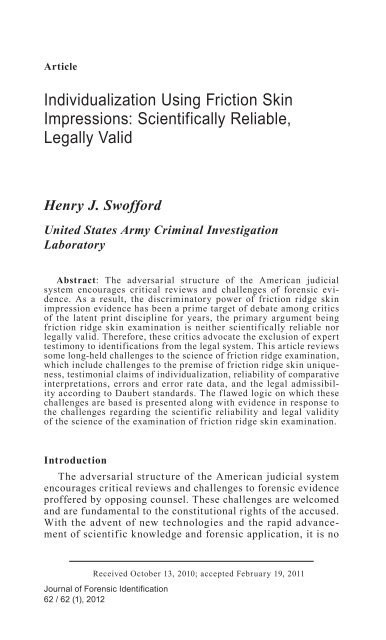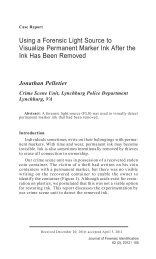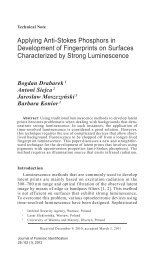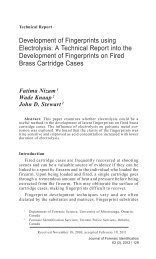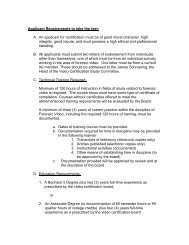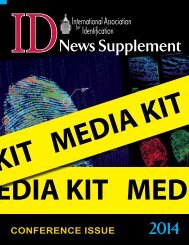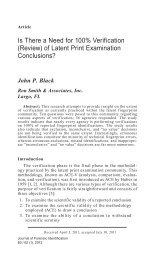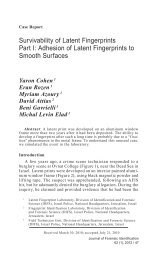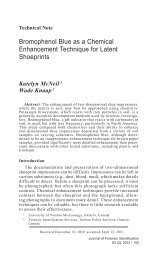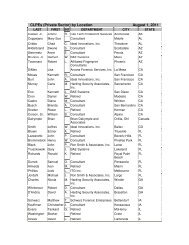Individualization Using Friction Skin Impressions: Scientifically ...
Individualization Using Friction Skin Impressions: Scientifically ...
Individualization Using Friction Skin Impressions: Scientifically ...
Create successful ePaper yourself
Turn your PDF publications into a flip-book with our unique Google optimized e-Paper software.
Article<br />
<strong>Individualization</strong> <strong>Using</strong> <strong>Friction</strong> <strong>Skin</strong><br />
<strong>Impressions</strong>: <strong>Scientifically</strong> Reliable,<br />
Legally Valid<br />
Henry J. Swofford<br />
United States Army Criminal Investigation<br />
Laboratory<br />
Abstract: The adversarial structure of the American judicial<br />
system encourages critical reviews and challenges of forensic evidence.<br />
As a result, the discriminatory power of friction ridge skin<br />
impression evidence has been a prime target of debate among critics<br />
of the latent print discipline for years, the primary argument being<br />
friction ridge skin examination is neither scientifically reliable nor<br />
legally valid. Therefore, these critics advocate the exclusion of expert<br />
testimony to identifications from the legal system. This article reviews<br />
some long-held challenges to the science of friction ridge examination,<br />
which include challenges to the premise of friction ridge skin uniqueness,<br />
testimonial claims of individualization, reliability of comparative<br />
interpretations, errors and error rate data, and the legal admissibility<br />
according to Daubert standards. The f lawed logic on which these<br />
challenges are based is presented along with evidence in response to<br />
the challenges regarding the scientific reliability and legal validity<br />
of the science of the examination of friction ridge skin examination.<br />
Introduction<br />
The adversarial structure of the American judicial system<br />
encourages critical reviews and challenges to forensic evidence<br />
proffered by opposing counsel. These challenges are welcomed<br />
and are fundamental to the constitutional rights of the accused.<br />
With the advent of new technologies and the rapid advancement<br />
of scientific knowledge and forensic application, it is no<br />
Received October 13, 2010; accepted February 19, 2011<br />
Journal of Forensic Identification<br />
62 / 62 (1), 2012
surprise that a number of these challenges involve the reliability<br />
of forensic evidence, particularly the identification (individualization)<br />
by means of friction ridge skin (i.e., fingerprints,<br />
palmprints, footprints). The discriminatory power of friction<br />
ridge skin examinations has been well accepted within the<br />
forensic community [1–3] and judicial systems [4, 5] to offer<br />
conclusive evidence of personal identification for more than<br />
one hundred years, and thus, when presented with such powerful<br />
evidence, defendants and defense counsels alike attempt to<br />
attack the scientific premise of biological uniqueness and the<br />
reliability of the scientific interpretations of source attributions<br />
offered by expert latent print examiners in an effort to cast doubt<br />
into the minds of the court and the jury.<br />
Although the science of friction skin examination is challenged<br />
in many areas, it is the focus of this paper to respond to some<br />
long-held challenges that attempt to reject the scientific reliability<br />
and legal validity of friction ridge skin examination. This<br />
rebuttal will be accomplished by first reviewing the arguments<br />
offered by some of the most well-known critics of the discipline<br />
and then providing arguments supporting the scientific reliability<br />
and legal validity of friction ridge skin examination as the<br />
product of extensive research in the various fields of biology,<br />
physiology, embryology, mathematics, physics, and chemistry<br />
that is well accepted by the scientific and legal communities.<br />
Challenging the Science of Fingerprint Identification<br />
There are two broadly defined challenges leveled against the<br />
science of friction ridge skin examination from which specific<br />
arguments stem:<br />
1. Few studies exist to validate the science and its application<br />
for personal identification [6-16].<br />
2. <strong>Friction</strong> ridge skin identification is legally admissible<br />
today only because the practice was grandfathered<br />
into the legal system when admissibility standards<br />
were, presumably, less stringent than they are today<br />
[12].<br />
Journal of Forensic Identification<br />
62 (1), 2012 \ 63
The specific arguments against the use of friction ridge<br />
skin as a means of personal identification, which stem from the<br />
broadly defined challenges listed previously, include:<br />
1. The uniqueness of friction ridge skin has not been<br />
proven because the friction skin of everyone in the<br />
world – past and present – has not been compared [6,<br />
7, 9, 11–16].<br />
2. Testimonial claims of individualization are not scientifically<br />
supported because the uniqueness of friction<br />
ridge skin has not yet been proven [6, 7, 9 , 12, 16].<br />
3. The unique characteristics of friction ridge skin exist<br />
on a metaphysical level and cannot be detected for the<br />
science to be applied [6].<br />
4. Human examiners cannot reliably interpret and discern<br />
the distinguishing characteristics of friction ridge skin<br />
from impressions to reliably apply the science [6, 8,<br />
10].<br />
5. <strong>Friction</strong> ridge skin examination does not satisfy the<br />
requirements set forth by Daubert which govern legal<br />
admissibility [8, 12, 13].<br />
Evidence of Scientific Reliability and Legal Validity<br />
Fundamentals of Science<br />
Science, as defined by Merriam-Webster, is “a body of facts<br />
learned by study or experience” [17]. Every scientific pursuit<br />
begins with an observation of phenomena. This initial observation<br />
is followed by additional observations of the phenomena,<br />
creating a mass of empirical data in which the initial observation<br />
is found to always be true with no contradictory evidence. Over<br />
time, as these observations continue to accumulate en masse,<br />
the reference as a scientific law may be established. A law, as<br />
defined by Merriam-Webster [18], is “a statement of an order or<br />
relation of phenomena that so far as is known is invariable under<br />
the given conditions”. When a law has been established stating<br />
an invariable result from observations under similar conditions,<br />
hypotheses are ultimately formed as testable explanations for the<br />
occurrence of the phenomena, and formal research is undertaken<br />
to understand the reasons for the observation. Once research<br />
has revealed the underlying cause of the phenomena observed, a<br />
theory is established. A theory, as defined by Merriam-Webster<br />
[19], is “a plausible or scientifically acceptable general principle<br />
Journal of Forensic Identification<br />
64 / 62 (1), 2012
or body of principles offered to explain phenomena”. Once a law<br />
has been established after rigorous observation and a theory has<br />
been established that explains the law through the accumulation<br />
of tested hypotheses, it is imperative that research be continuously<br />
undertaken in an effort to disprove the law or the theory.<br />
At any time, the law or the theory explaining the law may be<br />
shown to be wrong or may need to be modified if there is data<br />
to suggest so. As seen in every discipline of science, nothing in<br />
science is ever proven to the most absolute sense. However, each<br />
failed attempt to disprove the law or the theory adds additional<br />
knowledge and support for that law and theory.<br />
Uniqueness Premise<br />
The science of friction ridge skin examination, which is<br />
based on the premise that the arrangement of friction ridges<br />
are unique, and therefore can be individualized to a single<br />
source of friction skin, began as an observation more than three<br />
hundred years ago. In 1684, Dr. Nehemiah Grew, followed by G.<br />
Bidloo in 1685, began observing ridge and pore structures at a<br />
macroscopic level. Marcello Malpighi, using the newly invented<br />
microscope, studied the function and structure of friction skin<br />
at the microscopic level in 1686 [20–22]. Data from these initial<br />
observations continued to accumulate and in 1788, a common<br />
result from these observations was first stated by J. C. A. Mayer<br />
“that the arrangement of skin ridges is never duplicated in two<br />
individuals” [20]. This statement of order and relation of friction<br />
ridges has been observed since 1684 and continues to be invariably<br />
observed today.<br />
The first systematic use of friction ridge skin for personal<br />
identification was established by Sir William Herschel in 1860.<br />
In 1880, it was suggested by Dr. Henry Faulds that fingerprints<br />
may be used for personal identification and the detection of<br />
criminals in a letter to the editor of Nature. By 1892, the premise<br />
of friction ridge skin uniqueness had accumulated a mass of<br />
supporting empirical data, and the first statistical test was<br />
performed by Sir Francis Galton in an effort to determine the<br />
theoretical possibility that the arrangement of friction ridges<br />
is duplicated in two individuals. As the National Academies of<br />
Science has cited, Galton estimated that the probability of two<br />
fingerprints being duplicated from two sources of friction skin<br />
was “less than the reciprocal of 40 times the world population<br />
at that time” [3].<br />
Journal of Forensic Identification<br />
62 (1), 2012 \ 65
As time progressed, additional researchers and practitioners<br />
of the science observed the variation empirically and additional<br />
probabilistic models were created, adding further support to the<br />
premise. Despite the conservative nature of these models, each<br />
of them results in probabilities much less than the reciprocal of<br />
the world’s population. These models, as reviewed by Stoney in<br />
2001, include the Henry Model, 1900; Balthazard Model, 1911;<br />
Bose Model, 1917; Wentworth and Wilder Model, 1918; Cummins<br />
and Midlo Model, 1943; Gupta Model, 1968; Roxburgh Model,<br />
1933; Amy Model, 1946–48; Trauring Model, 1963; Kingston<br />
Model, 1964; Osterburg Model, 1977–80; Stoney and Thornton<br />
Model, 1985–89; Champod and Margot Model, 1995–96; and<br />
Meagher, Budowle, and Ziesig Model, 1999 [23].<br />
As technology advanced, medical researchers were able to<br />
begin understanding the underlying cause for these observations<br />
of friction ridge skin uniqueness. In 1926, Dr. Harold Cummins<br />
began researching the development of friction skin at Tulane<br />
University in Louisiana, which continued through 1946 [24].<br />
In 1952, Dr. Alfred Hale continued Dr. Cummins’ research by<br />
looking into the role that mechanical factors during embryonic<br />
development play in regulating the morphology of friction skin<br />
[25]. As studies of friction skin morphogenesis continued, the<br />
theory was established that mechanical and physical growth<br />
forces during embryonic development are the cause for the<br />
observed uniqueness of friction skin [25]. In 1969, Mulvihill and<br />
Smith, with reference to previous work by Penrose, introduced<br />
mathematical models explaining how random mechanical growth<br />
forces influence the delineation of the individual ridges [26, 27].<br />
These studies of embryonic development have continued through<br />
present day, most notably by Dr. William Babler [1, 28]. Over<br />
the course of the 20th century, in no single study of embryonic<br />
development was data shown to suggest the observed phenomena<br />
of friction ridge skin uniqueness as being false, which,<br />
inevitably, continually added further strength to the premise<br />
that friction ridge skin is unique [1]. This in no way, however,<br />
suggests research should not be continued in an effort to find<br />
contradictory evidence. Each failed attempt to disprove this<br />
premise adds further data in its support.<br />
Today, and for more than a century, the science of friction<br />
ridge skin examination has been, and continues to be, empirically<br />
tested by latent print examiners all over the world for identification<br />
(and elimination). Additionally, for more than thirty years,<br />
since the advent of the automated fingerprint identification<br />
Journal of Forensic Identification<br />
66 / 62 (1), 2012
system (AFIS), computerized comparisons have been conducted<br />
against millions of finger- and palmprints twenty-four hours a<br />
day, resulting in millions and possibly billions of comparisons.<br />
In no single instance throughout the course of the history of<br />
applying the science has empirical data been shown to disprove<br />
the uniqueness of friction ridge skin.<br />
<strong>Individualization</strong> Testimony<br />
Following the latter discussion of the development of the<br />
scientific premise that friction ridge skin is unique and the<br />
theory explaining the underlying causes for that uniqueness,<br />
the critics still argue that, despite the medical, mathematical,<br />
and empirical data available, friction ridge skin still has not<br />
been proven, in the most absolute sense, to be unique [6, 7, 9,<br />
11–16]. It is argued that without proving uniqueness, in the most<br />
absolute sense, the use of friction ridge skin for personal identification<br />
and making claims of “individualization to the exclusion<br />
of all others” is unscientific and therefore not acceptable by the<br />
general scientific community [6, 7, 9, 12, 16]. However, this<br />
assumption is neither accurate nor based on any valid logic. In<br />
the late 1980s, when scientists were faced with similar questions<br />
of proving uniqueness of the human genome, it was stated by<br />
the National Research Council (NRC), formed by the National<br />
Academy of Science (NAS), which is recognized as one of the<br />
most prestigious scientific organizations and representative of<br />
the general scientific community, that:<br />
If a sufficient set of DNA characteristics is measured, the<br />
resulting DNA profiles can be expected to be unique in<br />
all populations.... Of course it is impossible to establish<br />
uniqueness by profiling everyone in the world, but theory<br />
and experience suggests that this uniqueness is attainable<br />
in forensic typing. Indeed, some scientists would argue that<br />
the existing panoply of characteristics is already sufficient<br />
to permit unique identification in many cases. For example,<br />
it has been suggested that a probability much less than the<br />
reciprocal of the world’s population is a good indication of<br />
uniqueness. The committee has not attempted to define a<br />
specific probability that corresponds to uniqueness . . . but<br />
urges that research into new and cumulatively more powerful<br />
systems continue until a clear consensus emerges that<br />
DNA profiles, like dermal fingerprints, are unique. [3]<br />
Journal of Forensic Identification<br />
62 (1), 2012 \ 67
Despite the opinions of the NRC and the evidence supporting<br />
uniqueness, suggestions have been made to report examiner<br />
testimony in probabilistic terms [6, 7, 9, 29]. However, as<br />
mentioned by the NRC in 1996, the focus of attention should<br />
be on the jury’s ability to put proper weight on the conclusion<br />
without being confused with the technical jargon of that conclusion.<br />
This opinion of the NRC to focus on the ability of a jury to<br />
understand the evidence when providing examiner testimony is<br />
supported, interestingly, by Koehler, a prominent critic of testimonial<br />
claims of individualization, finding,“Previous research<br />
indicates that people struggle to understand the significance of<br />
probabilistic forensic science evidence...” [15]. In reference to<br />
expert testimony of reporting a match, the 1996 NRC states:<br />
<strong>Scientifically</strong> valid testimony about matching DNA [or<br />
fingerprints] can take many forms. The conceivable alternatives<br />
[of presenting expert testimony would] include<br />
statements of the posterior probability that the defendant<br />
is the source of the evidence DNA, qualitative characterizations<br />
of this probability, computations of the likelihood<br />
ratio for the hypothesis that the defendant is the source,<br />
qualitative statements of this measure of the strength of the<br />
evidence . . . and unadorned reports of a match. Courts or<br />
legislatures must decide which of these alternatives best<br />
meets the needs of the criminal justice system. At present,<br />
policymakers must speculate about the ability of jurors to<br />
understand the significance of a match as a function of the<br />
method of presentation. Solid, empirical research into the<br />
extent to which the different methods advance juror understanding<br />
is needed. [3]<br />
Considering the statement of the NRC in 1996, that “it is<br />
impossible to establish uniqueness by profiling everyone in the<br />
world, but theory and experience suggests that this uniqueness<br />
is attainable in forensic typing” and the urge “that research . .<br />
. continue until a clear consensus emerges that DNA profiles,<br />
like dermal fingerprints, are unique” [3], it can be deduced that<br />
the NRC is of the opinion that friction ridge skin uniqueness<br />
has been tested sufficiently enough for it to be considered a<br />
generally accepted natural phenomena and that it does not share<br />
the opinion of being unscientific to rely on theory and experience<br />
to suggest uniqueness. Furthermore, it is also clearly the<br />
opinion of the NRC that testimony of “qualitative statements of<br />
this measure of the strength of the evidence” and “unadorned<br />
reports of a match” are acceptable and valid forms of expert<br />
testimony [3].<br />
Journal of Forensic Identification<br />
68 / 62 (1), 2012
Interpretation of Uniqueness<br />
The critics continue to argue that even if uniqueness existed<br />
(noting that it has not been proven in the most absolute sense,<br />
but while making this logically invalid claim are rejecting the<br />
opinions of the general scientific community established by the<br />
NAS), we currently do not have the ability or tools to detect such<br />
uniqueness because it exists only in a metaphysical or rhetorical<br />
sense, that is, no “discernable uniqueness” [6, 8, 10]. In theory,<br />
this argument would carry some merit for discussion should the<br />
uniqueness of friction ridge skin only be observed at the cellular<br />
or molecular level; however, medical and empirical research<br />
has shown that the uniqueness of friction ridge skin pertains<br />
to the individual ridge delineation and characteristics observable<br />
at the macroscopic level [2, 30] and thus is well within the<br />
range of detection by the human observer, depending upon the<br />
quality of the impression. Latent print examiners typically rely<br />
on three levels of detail as described by Ashbaugh to quantitatively<br />
measure the clarity of the impression [30] and the<br />
ability to distinguish the unique characteristics. Level 1 detail<br />
describes the examiner’s ability to discern the overall pattern<br />
and aggregate ridge f low. Level 1 detail occurs in disproportionate<br />
amounts within the population according to statistical<br />
studies of the frequency of pattern types [31, 32]; however,<br />
individualizations cannot be effected solely on Level 1 detail<br />
because it is genetically influenced and shared by more than one<br />
individual. Level 2 detail, which is epigenetically influenced,<br />
describes the examiner’s ability to discern the individual ridge<br />
paths and ridge characteristics. And Level 3 detail, which is also<br />
epigenetically inf luenced, describes the examiner’s ability to<br />
discern the individual ridge unit shapes and pores. Levels 2 and<br />
3 detail define the characteristics that are unique to friction skin,<br />
and thus individualization conclusions can be logically deduced<br />
using the information from these levels [30]. Therefore, it is the<br />
quality of the impression that dictates the examiner’s ability<br />
to detect the individual characteristics and it is the quantity<br />
of those detected characteristics, when considered according<br />
to their location, orientation, and relative spatial relationship<br />
amongst one another, that enable the use of friction ridge skin<br />
for the purpose of personal identification [30].<br />
Journal of Forensic Identification<br />
62 (1), 2012 \ 69
Errors and Error Rates<br />
Having discussed the reliability of the science based on the<br />
uniqueness of friction ridge skin and the ability to discern that<br />
uniqueness by the human examiner, critics to the science often<br />
raise the question, Assuming that all areas of friction ridge skin<br />
are unique and assuming those unique characteristics can be<br />
detected, then why do errors exist? Their argument continues<br />
in this false logic that assuming the accuracy of those premises,<br />
then it should be assumed that the science is infallible. The<br />
argument often follows that because errors do exist, then the<br />
science must be fallible and therefore not reliable nor legally<br />
valid [8, 12, 13]. The inferences behind this latter argument do<br />
not follow standard deductive logic. The first mistake in this<br />
logic is the assumption that “because errors exist, the science<br />
is fallible”. The mistake critics often make is the confusion of<br />
the science with the application of the science. The difference<br />
between the science and the application of the science is the<br />
human factor. The potential for error exists in any endeavor<br />
undertaken by humans. The fact that errors exist does not necessarily<br />
invalidate the science or the application of that science.<br />
In fact, as stated by the NRC in 1996, “No amount of effort<br />
and improved technology can reduce the [human] error rate to<br />
zero.” But, “When errors are discovered, they are investigated<br />
thoroughly so that corrections can be made.”[3] Consider the<br />
airline industry, for example. The science behind the physics<br />
of flight is sound; however, airplanes still crash and people<br />
lose their lives. The frequency of these errors is miniscule, but<br />
the fact is that errors have occurred and will occur again at<br />
some point in the future. This unfortunate result does not mean<br />
the science is not reliable, but it does mean that at some point<br />
in the process, the practitioner of the science made an error.<br />
Through investigation, the cause of the error is determined and<br />
corrective action is taken, which might include re-training or<br />
dismissal. The science of friction ridge skin examination is no<br />
different from any other discipline where the human factor is<br />
involved. Errors have occurred in the application of the science;<br />
however, investigations have revealed that neither the science<br />
nor the methodology of that science is invalid [33]. Instead,<br />
the cause for the errors is the result of humans (insufficient<br />
training or improper application of the methodology) and corrective<br />
actions are employed. Consider, for example, the highly<br />
publicized erroneous identification of Brandon Mayfield by the<br />
Federal Bureau of Investigation (FBI). Following this erroneous<br />
identification by the FBI, critics began attacking the science<br />
Journal of Forensic Identification<br />
70 / 62 (1), 2012
of friction ridge skin examination as being unreliable and<br />
invalid as a means of personal identification [8, 34]. Following<br />
a thorough investigation of the incident by the United States<br />
Office of the Inspector General (OIG), it was later concluded<br />
that, among other contributing factors, the “misidentification<br />
could have been prevented through a more rigorous application<br />
of several principles of latent fingerprint identification”<br />
[33]. The incident was unfortunate, but a major contributing<br />
factor was the improper application of the science by those<br />
practitioners that resulted in the error.<br />
Now we are left with the argument often posed by critics<br />
that, regardless of whether errors occur because of the science<br />
or because of the improper application of the science, errors<br />
do occur and will continue to occur. This leads critics to the<br />
question of error rates. How often will errors occur in the<br />
future? How often have errors occurred in the past that have<br />
gone unnoticed [8, 10, 12–15, 34, 35]? Critics argue that there is<br />
no established rate of error for the science of friction ridge skin<br />
examination and often turn to using inappropriate measures of<br />
examiner reliability such as proficiency tests [36]. However, the<br />
Collaborative Testing Services, Inc. (CTS), which is a primary<br />
provider of proficiency testing in several forensic disciplines,<br />
released its “position on the unsuitability of our [its] reported<br />
results as a source for the determination of error rates for forensic<br />
science disciplines” in a statement published in March 2010<br />
[37]. Furthermore, according to the NRC, “Auditing and proficiency<br />
testing cannot be expected to give a meaningful estimate<br />
of the probability that a particular laboratory [or individual]<br />
has made such an error in a specific case. An unrealistically<br />
large number of proficiency tests would be needed to estimate<br />
accurately even a historical error rate.” [3] Additionally, as<br />
stated by the NRC in 1996:<br />
Estimating rates at which nonmatching samples are declared<br />
to match from historical performance on proficiency tests is<br />
almost certain to yield wrong values. . . . The risk of error<br />
is properly considered case by case, taking into account the<br />
record of the laboratory [or examiner] performing the tests,<br />
the extent of redundancy, and the overall quality of results.<br />
However, there is no need to debate differing estimates of<br />
false match error rates when the question of a possible false<br />
match can be put to direct test. [3]<br />
Journal of Forensic Identification<br />
62 (1), 2012 \ 71
Despite opinions of the highly respected NRC, it is still often<br />
argued that, because of the lack of a statistically acceptable<br />
rate of error for the profession, it fails admissibility standards<br />
under Daubert and therefore the science of friction ridge skin<br />
examination is not reliable and should not be admissible into the<br />
courts [8, 12, 13]. The critics are failing to realize, however, that<br />
the Daubert standard applies to the methodology and not to the<br />
practitioner because error rates that are due to the application<br />
of the science are a question of the competence of the individual<br />
applying the science and not of the science itself. “Practitioner<br />
error, then, falls outside the purview of a Daubert inquiry” [36]<br />
and, therefore, is in fact admissible under the Daubert standard.<br />
The legal opinion of this issue is that methods of latent print<br />
identification could be and have been tested in the adversarial<br />
system, results have been subjected to peer review, and the<br />
chance for error was exceptionally low [38]. Furthermore, with<br />
regards to the question of whether an error occurred in a particular<br />
case, the courts find that “vigorous cross-examination, [and]<br />
presentation of contrary evidence” [39, 40] is the appropriate<br />
means of assessing that possibility, whereas the NRC similarly<br />
feels that the possibility of a false match error can be tested [3].<br />
Daubert Standards for Legal Admissibility<br />
The remaining three admissibility standards under Daubert<br />
are also often grounds for challenges and include:<br />
1. Whether the type of evidence can be and has been<br />
tested by a scientific methodology.<br />
2. Whether the underlying theory or technique has been<br />
subjected to peer review and has been published in<br />
professional literature.<br />
3. Whether the method is “generally accepted” within<br />
the relevant scientific community.<br />
Critics challenge these three remaining admissibility<br />
standards that the science of friction ridge skin examination,<br />
as well as the premise of uniqueness, has not been tested by<br />
a scientific methodology and that the underlying theory or<br />
technique has not been subjected to peer review and publication;<br />
however, as discussed in detail earlier in this paper, these<br />
arguments have no logical basis. The premise to the science<br />
of friction ridge skin examination, the natural phenomena of<br />
friction ridge skin uniqueness, has been established through a<br />
mass of empirical observation and subjected to peer review and<br />
Journal of Forensic Identification<br />
72 / 62 (1), 2012
publication through multiple and various professional literature<br />
sources since the late 1600s. Additionally, the theory explaining<br />
the cause for this observed uniqueness has been tested using<br />
various methods both empirically and probabilistically beginning<br />
in the late 1800s. Furthermore, the science of friction<br />
ridge skin examination itself, of reliably applying the science,<br />
has been empirically demonstrated as well over the course of<br />
a century. Lastly, regarding the question of general acceptance,<br />
attempts are still made today to argue that the science<br />
of friction ridge skin examination is not generally accepted<br />
[41, 42] on the basis of the 2009 report by the NRC entitled<br />
Strengthening Forensic Science in the United States: A Path<br />
Forward [43]. These claims of lacking general acceptance are<br />
made without a basis. The science and application of the science<br />
is well accepted in the medical community, the forensic community,<br />
and the legal community. The science of friction ridge<br />
skin identification is used not only in the forensic discipline<br />
worldwide, but also in cases of identifying victims of natural<br />
disasters and in security verification systems both in government<br />
and in the private sector. Although the 2009 NRC report<br />
did indicate general areas where the forensic discipline could<br />
improve (addressing all areas of the forensic sciences) in accordance<br />
to their Congressional charge to “make recommendations<br />
for maximizing the use of forensic technologies and techniques<br />
to solve crimes, investigate deaths, and protect the public”, one<br />
of the 13 recommendations was, “Congress should authorize<br />
and appropriate funds . . . to launch a new broad-based effort to<br />
achieve nationwide fingerprint data interoperability . . . which<br />
could result in more solved crimes . . . and greater efficiency<br />
with respect to fingerprint searches.” [43] Such a recommendation<br />
by the NRC, representative of the highly respected general<br />
scientific community, is hardly one of lacking acceptance of the<br />
science of friction ridge skin examination. This statement of<br />
general acceptance is supported not only by the NRC in 2009,<br />
but also by its predecessors in 1992 and 1996. In 1992, the<br />
NRC, in its report on DNA evidence, stated, “Fingerprints were<br />
described as an individualizing characteristic as early as 1892 . .<br />
. minutiae in the fingerprint patterns, not ridge counts, are used<br />
for personal identification. The minutiae result from nongenetic<br />
events during embryonic development...” [2]. In 1996, when<br />
comparing DNA with friction ridge skin, a second NRC report<br />
states, “DNA analysis promises to be the most important tool for<br />
human identification since Francis Galton developed the use of<br />
fingerprints for that purpose. We can confidently predict that,<br />
Journal of Forensic Identification<br />
62 (1), 2012 \ 73
in the not-distant future, persons as closely related as brothers<br />
will be routinely distinguished, and DNA profiles will be as<br />
fully accepted as fingerprints now are.” [3] General acceptance<br />
is found not only in the scientific community [2, 3, 43], but it<br />
has also been found in the legal arena from 1911 until the present<br />
day [4, 5, 38, 40-42, 44-50].<br />
Conclusion<br />
This paper reviewed some long-held challenges to the science<br />
of friction ridge skin examination argued by some of the most<br />
well-known critics of the discipline. The primary focus of their<br />
arguments is that friction ridge skin cannot be reliably individualized<br />
to a single source to the exclusion of all others. Their<br />
arguments are supported by claims that the uniqueness of friction<br />
ridge skin has not been proven, and, if proven, is metaphysical<br />
and cannot be detected by the examiner to reliably apply the<br />
science. The critics assert that the science is not reliable and<br />
therefore is not legally valid. Furthermore, the critics attempt<br />
to exclude the application of the science of friction ridge skin<br />
examination from American courtrooms by suggesting its legal<br />
inadmissibility according to the Federal Rules of Evidence 702,<br />
which codified Daubert, that the science has not been tested and<br />
validated, has not been subjected to peer review and publication,<br />
does not have a known or predictive rate of error, and is not<br />
generally accepted by the relative scientific community.<br />
This paper, however, demonstrates the flawed logic on which<br />
these claims rest. By arguing against the scientific reliability of<br />
friction ridge skin examination and claiming that the uniqueness<br />
of friction ridge skin has not been proven, and if proven, could not<br />
be detected, these critics are ignoring the theory and experience<br />
that have risen from the observations that occurred beginning<br />
in the late 17th century and subsequent medical research that<br />
has been performed since the early 1900s through present day.<br />
These critics are also ignoring the multiple probabilistic models<br />
that have been developed since 1892, the mass of empirical data<br />
that has accumulated since 1860 when friction ridge skin was<br />
first systematically used for the purpose of personal identification,<br />
and the billions of comparisons conducted through AFIS<br />
databases all over the world since the late 1970s and early 1980s<br />
when the AFIS technology was first introduced.<br />
By arguing that the science of friction ridge skin examination<br />
is not legally valid and is inadmissible under the Federal Rules<br />
of Evidence 702, as codified by Daubert, the critics are failing<br />
Journal of Forensic Identification<br />
74 / 62 (1), 2012
to take into consideration the scientific reliability established by<br />
the mass of medical, probabilistic, and empirical data accumulated<br />
over the last three hundred years in which the science<br />
has been tested, subjected to peer review and publication, and<br />
validated for judicial application. Additionally, the critics are<br />
failing to take into account the blatant general acceptance of the<br />
science by latent print examiners all over the world, as well as<br />
the more general and highly respected scientific community, the<br />
National Academy of Science, which is represented by multiple<br />
research committees (NRCs) organized, in part, to review the<br />
scientific reliability and legal validity of friction ridge skin<br />
examination. Furthermore, the critics are ignoring the statements<br />
of the NRC and multiple legal rulings in reference to<br />
friction ridge skin uniqueness, the calculation of historical and<br />
predictive rates of error, the root cause of the very few known<br />
errors that have occurred in the profession throughout history,<br />
and the validity of testimonial claims of individualization.<br />
As this paper demonstrates, the arguments offered by these<br />
critics are fallacious in nature and lack scientific and legal<br />
support. It can be well agreed that the fundamental premise<br />
of friction ridge skin uniqueness has withstood considerable<br />
scrutiny since the late 17th century. Furthermore, considering<br />
the most basic definition of scientific law and theory, this paper<br />
proposes that friction ridge skin uniqueness is well within the<br />
bounds to be considered a scientific law that will occur invariably<br />
as a natural phenomenon, and it should be recognized, as<br />
such, along with the underlying cause for this phenomenon being<br />
theorized as the result of random mechanical growth forces<br />
occurring during embryonic development. However, despite<br />
the research and knowledge currently available that serve as<br />
the foundational support for the scientific reliability and legal<br />
validity of friction ridge skin examinations, challenges to the<br />
science are continually welcomed and encouraged for the sake of<br />
scientific advancement. Because nothing in science can ever be<br />
proven in the most absolute sense, new and additional research<br />
will always be warranted until contradictory evidence is discovered.<br />
Each failed attempt to disprove the science of friction ridge<br />
skin examination with contradictory evidence adds additional<br />
strength and support to its established scientific reliability and<br />
legal validity. Although research is warranted in many areas<br />
to further advance the science, a failure to acknowledge the<br />
information gained and foundation established to date would<br />
be unwarranted.<br />
Journal of Forensic Identification<br />
62 (1), 2012 \ 75
Acknowledgment<br />
The author would like to acknowledge Rodney Schenck and<br />
Mandi Hornickel (U.S. Army Criminal Investigation Laboratory)<br />
for their assistance in reviewing this paper and providing important<br />
improvements.<br />
The opinions or assertions contained herein are the private<br />
views of the author and are not to be construed or as reflecting<br />
the views of the United States Department of the Army or the<br />
United States Deparment of Defense.<br />
For further information, please contact:<br />
References<br />
Henry J. Swofford<br />
United States Army Criminal Investigation Laboratory<br />
4930 North 31th Street<br />
Forest Park, GA 30297<br />
Henry.Swofford@us.army.mil<br />
1. Swofford, H. J. The Ontogeny of the <strong>Friction</strong> Ridge: A<br />
Unified Explanation of Epidermal Ridge Development with<br />
Descriptive Detail of Individuality. J. For. Ident. 2008, 58<br />
(6),682–695.<br />
2. DNA Technology in Forensic Science; National Research<br />
Council, National Academy Press: Washington, DC, 1992.<br />
3. The Evaluation of Forensic DNA Evidence; National Research<br />
Council, National Academy Press: Washington, DC, 1996.<br />
4. People v Jennings, 96 N.E. 1077, (Ill. 1911).<br />
5. United States v Bryon Mitchell, 365 F.3d 215, (3rd Cir. 2004).<br />
6. Saks, M. J.; Koehler, J. J. The <strong>Individualization</strong> Fallacy in<br />
Forensic Science Evidence. Vand. L. Rev. 2008, 61, 199–219.<br />
7. Kaye, D. H. Probability, <strong>Individualization</strong>, and Uniqueness<br />
in Forensic Science Evidence: Listening to the Academies.<br />
Brooklyn Law Review 2009, 75 (4), 1–23.<br />
8. Cole, S. A. Is Fingerprint Identification Valid? Rhetorics<br />
of Reliability in Fingerprint Proponents’ Discourse. Law &<br />
Policy 2006, 28 (1), 109–135.<br />
9. Cole, S. A. Forensics without Uniqueness, Conclusions without<br />
<strong>Individualization</strong>: The New Epistemology of Forensic<br />
Identification. Law, Probability and Risk 2009, 8 (3), 233–<br />
255.<br />
10. Cole, S. A.; Welling, M.; Dioso-Villa, R.; Carpenter, R.<br />
Beyond the Individuality of Fingerprints: A Measure<br />
of Simulated Computer Latent Print Source Attribution<br />
Accuracy. Law, Probability and Risk 2008, 7 (3), 165–189.<br />
Journal of Forensic Identification<br />
76 / 62 (1), 2012
11. Kay, D. H. Questioning a Courtroom Proof of the Uniqueness<br />
of Fingerprints. Int. Stat. Rev. 2003, 71 (3), 521–533.<br />
12. Epstein, R. Fingerprints Meet Daubert: The Myth of<br />
Fingerprint “Science” is Revealed. Southern California Law<br />
Rev. 2002, 75, 605–658.<br />
13. Haber, R.; Haber, L. Er ror Rates for Human Latent<br />
Fingerprint Examiners. In Advances in Automatic Fingerprint<br />
Recognition; Ratha, N. K., Ed.; Springer-Verlag: New York,<br />
2004; pp 339–360.<br />
14. Schwinghammer, K. Fingerprint Identification: How “The<br />
Gold Standard of Evidence” Could Be Worth Its Weight.<br />
Amer. J. Crim. Law 2005, 32, 265–289.<br />
15. Koehler, J. J. Fingerprint Error Rates and Proficiency Tests:<br />
What They Are and Why They Matter. Hastings Law J. 2008,<br />
59 (5), 1077–1100.<br />
16. Koehler, J. J. Forensic Science Reform in the 21st Century:<br />
A Major Conference, A Blockbuster Report and Reasons to<br />
be Pessimistic. Law Probability and Risk 2010, 9 (1), 1–6.<br />
17. “Science.” Merriam-Webster Online Dictionary. 2010.<br />
Merriam-Webster Online, www.merriam-webster.com/dictionary/science<br />
(accessed 7 March 2010).<br />
18. “Law.” Merriam-Webster Online Dictionary. 2010. Merriam-<br />
Webster Online, www.merriam-webster.com/dictionary/law<br />
(accessed 7 March 2010).<br />
19. “Theory.” Merriam-Webster Online Dictionary. 2010.<br />
Merriam-Webster Online, www.merriam-webster.com/dictionary/theory<br />
(accessed 7 March 2010).<br />
20. Moenssens, A. A. Fingerprints and the Law; Chilton Book<br />
Company: Philadelphia, PA, 1969; pp 1–9.<br />
21. Bridges, B. C.; O’Hara, C. E. Practical Fingerprinting; Funk<br />
and Wagnalls Company: New York, 1963; pp 9–18.<br />
22. Chapel, C. E. Fingerprinting: A Manual of Identification;<br />
Coward McCann, Inc.: New York, 1941; pp 3–10.<br />
23. Stoney, D. A. Measurement of Fingerprint Individuality. In<br />
Advances in Fingerprint Technology, 2nd ed.; Lee, H. C.,<br />
Gaensslen, R. E. Eds.; CRC Press: Boca Raton, FL, 2001;<br />
pp 327–388.<br />
24. Cummins, H. Dermatoglyphics: Significant Patternings of<br />
the Body Surface. Yale J. Bio. and Med. 2000, 73 (1–6),<br />
79–90. (Reprinted from Med. and Surg. 1946, 18, 551–565).<br />
25. Hale, A. R. Morphogenesis of Volar <strong>Skin</strong> in the Human Fetus.<br />
Am. J. Anat. 1952, 91 (1), 147–181.<br />
26. Mulvihill, J.; Smith, D. The Genesis of Dermatoglyphics. J.<br />
of Pediat. 1969, 75 (4), 579–589.<br />
27. Penrose, L. Medical Significance of Fingerprints and Related<br />
Phenomenon. Br. Med. J. 1968, 2 (5601), 321–325.<br />
Journal of Forensic Identification<br />
62 (1), 2012 \ 77
28. Babler, W. Embryologic Development of Epidermal Ridges<br />
and their Configurations. In Dermatoglyphics: Science in<br />
Transition, Birth Defects Original Article Series; March of<br />
Dimes: Washington DC, 1991, 27 (2), 95–112.<br />
29. Champod, C.; Evett, I. W. A Probabilistic Approach to<br />
Fingerprint Evidence. J. For. Ident. 2001, 51 (2), 101–122.<br />
30. Ashbaugh, D. Quantitative-Qualitative <strong>Friction</strong> Ridge<br />
Analysis; CRC Press: Boca Raton, FL, 1999.<br />
31. Cummins, H.; Midlo, C. Fingerprints, Palms, and Soles: An<br />
Introduction to Dermatoglyphics; The Blakiston Company:<br />
Philadephia, 1943; pp 67–70.<br />
32. Swofford, H. J., Fingerprint Patterns: A Study on the Finger<br />
and Ethnicity Prioritized Order of Occurrence. J. For. Ident.<br />
2005, 55 (4), 480–488.<br />
33. Office of the Inspector General (OIG); A Review of the<br />
FBI’s handling of the Brandon Mayfield Case. (Unclassified<br />
Executive Summary) U.S. Department of Justice: Washington,<br />
DC, 2006, p 6.<br />
34. Cole, S. A. More Than Zero: Accounting for Error in Latent<br />
Fingerprint Identification. J. Crim. Law and Criminology<br />
2005, 95 (3), 985–1078.<br />
35. Dror, I. E.; Charlton, D.; Peron, A. E. Contextual Information<br />
Renders Exper ts Vulnerable to Making Er roneous<br />
Identifications. For. Sci. Int. 2006, 156, 74–78.<br />
36. Wertheim, K.; Langenburg, G.; Moenssens, A. A Report<br />
of Latent Print Examiner Accuracy During Comparison<br />
Training Exercises. J. For. Ident. 2006, 56 (1), 55–93.<br />
37. Collaborative Testing Services Inc., CTS Statement on the Use<br />
of Proficiency Testing Data for Error Rate Determinations.<br />
March 2010, p 1–3.<br />
38. United States v Harvvard, 260 F.3d 597 (7th Cir. 2001).<br />
39. Daubert v Merrell Dow Pharmaceuticals, Inc., 509 U.S. 579,<br />
113 S. Ct. 2786 (1993).<br />
40. United States v Baines, F.3d, 2009 WL 2139117 (10th Cir.<br />
2009).<br />
41. United States v Keita, Crim. Case No. 2008 CF 2 26777<br />
(2009).<br />
42. State of Oregon v Angius, Case No. 200924231, Motion In<br />
Limine to Exclude Fingerprint Evidence, In the Circuit Court<br />
for the State of Oregon for Lane County, 2010.<br />
43. Committee on Identifying the Needs of the Forensic Sciences<br />
Community, National Research Council. Strengthening<br />
Forensic Science in the United States: A Path Forward.<br />
National Academies Press: Washington, DC, 2009.<br />
44. United States v Patrick Crisp, 324 F.3d 261 (4th Cir. 2003).<br />
45. United States v Abreu, 406 F.3d 1304, 1307 (11th Cir. 2005).<br />
Journal of Forensic Identification<br />
78 / 62 (1), 2012
46. United States v Douglas, 489 F.3d 1117 (11th Cir. 2007).<br />
47. United States v Llera Plaza, 188 F.Supp.2d 549 (E.D. Pa.<br />
2002).<br />
48. State of New Hampshire v. Richard Langill, Supreme Court<br />
of New Hampshire, Case No. 2007-300, Opinion Issued April<br />
4, 2008.<br />
49. United States v Cline, 349 F.3d 1276 (10th Cir. 2003).<br />
50. United States v Janis, 387 F.3d 682, (8th Cir. 2004).<br />
Journal of Forensic Identification<br />
62 (1), 2012 \ 79


